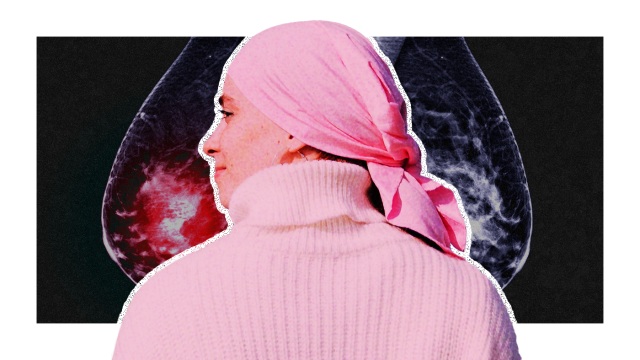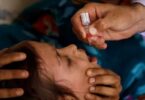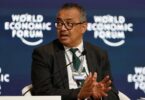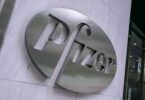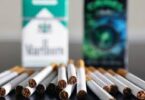Nathaniel Weixel and Julia Manchester
Tammy Moyle’s annual mammogram in March was clean. But then she discovered a small lump a few months later. The diagnosis came in August. It was early-stage invasive lobular carcinoma, an aggressive form of breast cancer that’s treatable if caught early enough.
Because it was caught so early, the 45-year-old mother of three said doctors told her there’s a 96 percent cure rate. She will need 12 weeks of chemotherapy, and will also be taking an infusion drug called Herceptin for the next nine months.
“If I had to get cancer, like God forbid anyone ever gets cancer, but if I had to get cancer, I feel like this is the time to have it. You know, we have so many advancements. I feel really hopeful about my outcome,” Moyle said.
Moyle’s experience captures both the exasperation and optimism in the battle against breast cancer. While rates continue to creep up year-on-year, particularly among younger women, evolutions in diagnostics and treatment mean breast cancer patients face far better prospects than ever before.
Rapid drug development, personalized screening recommendations, targeted therapies and new treatments like immunotherapies have all helped women diagnosed with early stage and even metastatic breast cancer.
“We’re increasingly more specific, personalized, individualized about the type of treatment that we can offer patients and the lines of treatment that they can have,” said Elizabeth Comen, a breast oncologist at Memorial Sloan Kettering Cancer Center in New York.
Breast cancer accounts for 31 percent of all cancers in women, the most common type, according to the American Cancer Society. Nearly 300,000 women will likely be diagnosed with breast cancer in 2023. It will likely kill about 43,000 of them.
Despite the scientific advances, declines in mortality have slowed in recent years, and incidence rates have been slowly increasing by about 0.5 percent per year since the mid-2000s, according to the American Cancer Society.
This rise in diagnoses is due in part to more women having obesity, having fewer children, or having their first baby after age 30, the organization said. It may also be because of lower rates of screening.
While a breast cancer diagnosis is rare for women under 40, it is the leading cause of all cancer deaths in women between the ages of 20 and 49. And the diagnoses among those younger women are rising.
“There’s definitely a stigma around breast cancer like you don’t need to worry about it until you’re 40 or over, but that’s definitely not the case,” said Brianna Osofisan, 26, who was diagnosed with stage two breast cancer when she was 21 years old and heading into her senior year of college.
“It was definitely very unexpected, especially being a senior in college and trying to figure out my plans after graduation and then having to deal with the weekly doctor appointments and treatment on top of that,” she said.
A study published in JAMA Network Open in August showed all cancers are on the rise for younger women, particularly those younger than 50.
“This is not just because we’re screening women earlier because frankly, we don’t have guidelines for screening women earlier. They are being diagnosed more and they are being diagnosed with more aggressive cancers,” Comen said. “I cannot more passionately or emphatically state that this is an area of research that absolutely must improve. We need to address this unmet need.”
William Dahut, chief scientific officer of the American Cancer Society, noted the risk of breast cancer is significantly higher among older women, and while the absolute numbers of younger women being diagnosed are relatively low, they are undeniably increasing.
“We’re seeing similar trends in other cancers, colorectal cancer, for example, too. So there is something going on, which is increasing cancer in younger patients,” Dahut said.
Screening mammograms are only recommended [LINK] for women between the ages of 40 and 74. Experts say there isn’t enough evidence of benefit or cost effectiveness in screening women younger than 40. There are also concerns over potential harms of screening, including the psychological toll of false positives.
Ann Patridge, an oncologist and founder of Dana Farber Cancer Institute’s Program for Young Adults with Breast Cancer, said America will likely move toward population-based screening for cancer predisposing genes.
However, that carries its own complications — such as forcing young women to decide whether to remove their ovaries or breast based on statistical guesses about their chances of getting cancer. And even if they are high risk, those prevention options are likely not going to be palatable for young women.
There’s a growing group of experts and advocates who want more research into lowering the recommended age of breast cancer screenings.
The recommendation from the U.S. Preventive Services Task Force (USPSTF) for women to start mammograms at 40 is only a draft, and was released earlier this year. Prior to that, USPSTF called for women with an average risk of breast cancer to begin screening at age 50.
Tari King, chief of the division of breast surgery at Brigham and Women’s Hospital in Boston, said she was happy to see the recommended age lowered to 40, but highlighted that some women need to start even earlier.
“What we need to recognize is that if the first time that you’re talking to your doctor about your breast cancer risk is at the age of 40, that’s probably too late,” King said.
King said younger women should have conversations with their primary care doctors or OB-GYNs about topics like family history of breast cancer and lifestyle habits that could be putting them at increased risk. Providers can then use that information to help determine whether starting screening earlier would be beneficial.
“Getting risk assessments early will allow us to identify women who may actually need to start screening before the age of 40,” King said.
Experts said there are different clinical considerations for younger women than older women, particularly around fertility.
But preserving the ability of a young woman to have children isn’t always an option.
Lourdes Monje, who was diagnosed at 25 years-old and is living with stage 4 metastatic breast cancer, said she is going through chemical menopause, so can’t become pregnant.
“When you become pregnant, your body produces a ton of estrogen and that’s the last thing that we would want to do for my type of cancer because my cancer feeds on estrogen,” she said.
Patients with metastatic cancer cannot currently be cured, but there have been new drugs approved and new clinical trials, so when one treatment stops working, they can move to another. Eventually though, they will likely exhaust options.
Monje said that her diagnosis and treatment has shifted her own perspective on what’s next in life.
“Even though my doctor told me what side effects to expect, I don’t think I was quite prepared for the emotional part of it,” she said. “I process my emotions very differently than I used to and I think that was very hard for me to deal with because I felt like I didn’t know myself for a long time.”
There have also been research advances into the genetics of cancer, though the field is still evolving. Genetic counseling and genetic testing can help identify a person’s risk, and whether they have the breast cancer gene (BRCA) and other gene mutations.
Alejandra Campoverdi decided to get tested for the BRCA gene because of her family history. Her mother, grandmother, great-grandmother, and two aunts were all diagnosed with breast cancer.
“When I came up positive, it wasn’t a huge surprise but I realized there was something I could do preventative about it,” said Campoverdi, who was 38 at the time.
She went on to have a double mastectomy, during which doctors caught an early-stage, non-invasive breast cancer. Campoverdi said the experience led to her work in breast cancer advocacy, particularly focused on the Latino community.
Campoverdi noted how there is a lack of Spanish-language material on breast cancer prevention or advocacy in the space targeted toward Latinas, despite breast cancer being the leading cause of death for Hispanic women, according to the Mayo Clinic.
She has since co-produced a documentary on BCRA and hereditary cancer and launched the Latinx and BRCA initiative at the University of Pennsylvania Health System.
Experts and survivors strongly encourage women of all ages, particularly young women less familiar with breast cancer prevention, to get into the regular habit of practicing self-exams.
“For an average risk young woman, we recommend sticking to physical exam and being aware of one’s breast health and how one’s breasts feel, and to bring any concerning signs and symptoms…to medical attention,” Partridge said.
Among the signs and symptoms to look out for: breast lumps that get bigger or don’t go away with a menstrual cycle, discolored/bloody nipple discharge, skin rash/dimpling, or a lump in the underarm.
However, some younger women who were eventually diagnosed with breast cancer say that they felt their concerns were often brushed off by their medical providers.
Meghan McCallum was 32 when she was first diagnosed in 2019. She suspected something was off after a self-examination that year, but it took until Christmas to get an official diagnosis.
“I had a gut feeling,” McCallum said. “I felt confident in my knowing that something wasn’t right with body. That was just the very beginning of what ended up being a very unfortunately long process of getting a correct diagnosis.”
Most doctors told McCallum she was too young to have breast cancer, or likely had a benign breast tumor known as a fibroadenoma.
“It took a lot of visits and calling out doctors again and again to be taken seriously to get a correct diagnosis,” she said. “There were all of these things that I just had never experienced before and I didn’t have the self-advocacy tool in my toolbelt to really think about this from that lens of maybe my doctors are wrong and what if this is actually cancer.”
While much of the advocacy around breast cancer continues to focus on older patients, more groups are geared toward younger generations.
Osofisan, Monje, and McCallum are part of the Young Survival Coalition, an international organization aimed at supporting people who have been diagnosed with breast cancer under the age of 40.
“Now that I’m in it, I do meet a lot more people and I also meet a lot of young people who had a similar situation to me,” Monje said. “One of the first things I had trouble with was finding people like me, but that’s how I wound up at Young Survival Coalition.”
While genetic testing and screening can help, sometimes a cancer diagnosis comes seemingly out of nowhere.
Elissa Kalver, 36, was diagnosed with stage 4 metastatic breast cancer when she was 34, shortly before her daughter’s first birthday.
Kalver said she has no family history, and nothing showed up on genetic screenings. She even had a breast exam just two months before ultimately finding a lump. Things moved quickly after that, and tests showed the cancer had spread.
“So I’ve had cancer on my breasts and my lymph nodes, my liver, my spine, my brain,” Kalver said.
Kalver said she struggled with feeling powerless. So during an early round of chemotherapy, she started a national nonprofit called We Got This, which is a gift registry and marketplace for people with cancer.
She said she is often asked why her cancer wasn’t caught earlier, before it metastasized.
“I think a lot of that mentality is a bit toxic, because one, it is kind of blaming me. Like, no, I couldn’t find it earlier. You know, I went to tons of doctors, they knew something was wrong, but nothing led to [cancer,]” Kalver said.
Her cancer was so metastasized that she suspects it was spreading undetected for at least a year.
“In hindsight, there’s nothing more I could have done, other than if I like had a crystal ball to push to get a mammogram. But, like, how would I have known that at 34?”
Kalver said she wants to increase awareness of late-stage breast cancers. Breast Cancer Awareness Month each October puts a public focus on prevention and making sure women conduct self-exams. But she said there’s not as much attention on what happens if you’re already too late.
“And when what happens, like to me, which is kind of the worst case scenario … then, you know, not just pounding sand but having solutions too,” she said. “You know, I don’t want to just accept that I have stage four cancer and I’m gonna die. You know, there’s a lot of solutions for what I have. And I’m really lucky that they exist.”
Courtesy: thehill

